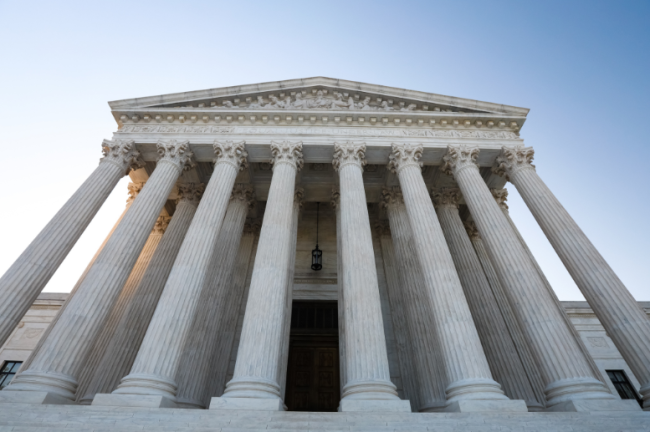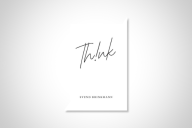You have /5 articles left.
Sign up for a free account or log in.

P_Wei/Getty Images Signature
Each season’s batch of university-press catalogs will echo, or occasionally anticipate, developments in the news just as much as trade publishers’ listings do. And sometimes even more so, as it seems this spring—with books on the Supreme Court of the United States pushing their way conspicuously into view.
The most unabashedly celebratory is Jocelyn J. Evans and Keith Gaddie’s The U.S. Supreme Court’s Democratic Spaces, originally published in 2021 and soon out in paperback (University of Oklahoma Press, April). As the “shining temple to the American idea of justice,” the building itself (which opened in 1935) “defines a cultural, social, and political space in the public imagination.” (All quotations in this column are taken from catalog descriptions.) Telling the story of “the Court’s evolution and its succession of earlier homes in Washington, D.C., Philadelphia, and New York,” the authors take its neoclassical design (shared with the White House and the Capitol buildings, which were older) to be “a coherent architectural representation of governmental power in the capital city.”
But the majestic architecture houses an institution never fully insulated from the fray of American politics. Kevin J. McMahon’s A Supreme Court Unlike Any Other: The Deepening Divide Between the Justices and the People (University of Chicago Press, April) charges that the present court has lost its moorings in “the democratic processes that help establish its authority.” Revisiting “court battles during presidencies ranging from FDR to Donald Trump,” the author explores “the altered politics of nominating and confirming justices, the shifting pool of Supreme Court hopefuls, and the increased salience of the Court in elections.”
Another take on how SCOTUS and the American political landscape affect one another can be found in Dave Bridge’s Pushback: The Political Fallout of Unpopular Supreme Court Decisions (University of Missouri Press, March). While the court is not beholden to public opinion, its rulings have typically been in accord with a majority of public opinion. (Indeed, many pass without attracting much attention from the populace at all.) But when decisions go against majority sentiment, the repercussions for “the Court, political parties, party formation, and politics in general” can be complex.
The author combines crunched numbers (“e.g., polls, number of congressional proposals, roll call tallies, breakdown of factional affiliations”) with historical narrative, with a particular focus on one recent unpopular Supreme Court decision: Dobbs v. Jackson Women’s Health Organization, which overturned Roe v. Wade despite about two-thirds of the American public supporting the earlier ruling.
The impact of Dobbs is the shared focus of three spring titles. Deborah R. McFarlane and Wendy L. Hansen’s Regulating Abortion: The Politics of US Abortion Policy (Johns Hopkins University Press, May) places the Dobbs ruling in context of abortion as a “heavily regulated and politically divisive health care service” during the half century making up the Roe v. Wade era. The authors present their work as “a comprehensive analysis of US abortion policy contextualized by relevant Supreme Court decisions and a comparative exploration of abortion regulation in Western Europe.”
Angie Leventis Lourgos draws on her reporting for the Chicago Tribune in Life-Altering: Abortion Stories from the Midwest (University of Missouri Press, January). Her coverage of reproductive rights in the Midwest before 2022 showed how access to the procedure was being curtailed through “mandatory waiting periods, early gestational limits, and a dearth of abortion providers” even while Roe v. Wade was on the books.
Based on interviews with women who terminated their pregnancies before and after Dobbs, the author depicts “how court cases, state legislation, and religious beliefs can affect the lives and reproductive choices of ordinary people.”
The recent pushback is in evidence with Fighting Mad: Resisting the End of Roe v. Wade (University of California Press, March), where editors Krystale E. Littlejohn and Rickie Solinge assemble essays by “activists and artists, academics and abortion storytellers, health care professionals and legislators, [and] clinic directors and lawyers.” The contributors assess “the impacts of criminalization, efforts to protect the targeted, shortcomings of the past, and visions for the next generation.”
What might be called SCOTUS clairvoyance—the effort to read the minds of the members of the court regarding the cases before it—is a perpetually tempting form of inside baseball. (Wagering is imprudent.) But Peter Charles Hoffer’s The Supreme Court Footnote: A Surprising History (NYU Press, June) shows how many clues into the justices’ thinking become available after a ruling—at the bottom of the page.
Ranging from Chisholm v. Georgia in 1792 (“a case concerning federalism vs. states’ rights”) to Dobbs v. Jackson Women’s Health, the author shows how, “as justices alter the course of history via their decisions, they import their own understandings of it through the footnotes.” Between the majority opinion and the dissents, the Dobbs decision generated more than 150 footnotes that “held immense significance, unveiling justices’ beliefs about the Constitution’s essence, highlighting their controversial reasoning, and laying bare the vastly different interpretations of the role of Supreme Court Justice.”
With Trump v. Anderson (to use the abbreviated name of the case on the SCOTUS docket yesterday), it is not exactly wild speculation to suggest that some justices will frame their opinions along lines developed in Randy E. Barnett and Evan D. Bernick’s monograph from 2021, The Original Meaning of the Fourteenth Amendment: Its Letter and Spirit, soon available in paperback (Harvard University Press, April).
The authors, who contend that “the Supreme Court has long misunderstood or ignored the original meaning of the amendment’s key clauses,” are known as advocates of “public-meaning” or “semantic” originalism. Earlier Constitutional originalists argued that the legitimate application of the Constitution had to be in accord with the framers’ intentions. The public-meaning variety holds that a statute’s valid interpretation is defined by how its language would have been understood by an informed reader when it was enacted.
Barnett and Bernick are primarily concerned with the 14th Amendment’s much-invoked Section 1, a.k.a. “the equal protection clause.” The question of the implications of Section 3, which bars insurrectionists from holding public offices, was a very niche question until recently, but a public-meaning originalist might point out that Donald Trump was never in the Confederate Army. That is, indeed, indisputable, and certain originalist-minded justices are bound to point it out.








